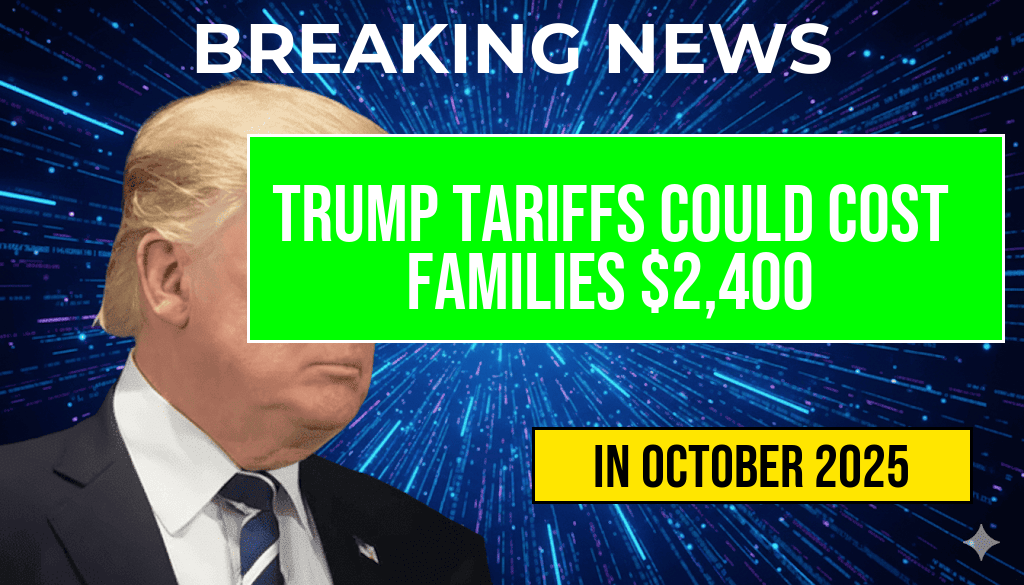The ongoing tariffs imposed during the Trump administration may lead American families to face an additional annual cost of approximately $2,400, according to a recent analysis by economists and consumer advocacy groups. Dubbed the “Turbulence Tax,” this financial burden is a direct consequence of increased prices on various goods, including electronics, clothing, and household products. As the country grapples with inflation and supply chain disruptions exacerbated by these tariffs, many households are questioning the long-term effects of these trade policies on their budgets. The implications of this substantial financial impact are being felt across the nation, raising concerns about consumer spending and economic recovery.
Understanding the Turbulence Tax
The term “Turbulence Tax” refers to the unintended economic consequences stemming from the tariffs originally intended to protect American industries. According to a report from the Forbes Tech Council, the average American family has already begun to notice a significant uptick in the prices of imported goods. This phenomenon is particularly pronounced in industries heavily reliant on foreign manufacturing.
Key Areas Affected by Tariffs
- Electronics: Prices for consumer electronics have surged, with some estimates suggesting a 20% increase in costs.
- Apparel: Clothing prices have also seen notable hikes, impacting families who rely on affordable fashion.
- Household Goods: Items such as furniture and appliances have become pricier, straining household budgets.
Economic Analysis of Tariff Effects
Economists have conducted detailed studies to assess the broader impact of these tariffs on American households. A recent analysis by the National Bureau of Economic Research highlighted that the average family could see their annual expenses rise significantly due to increased costs of goods. The study emphasizes that the burden of these tariffs disproportionately affects low- and middle-income families, who spend a larger percentage of their income on consumer goods.
Consumer Sentiment and Spending
The rising costs have led to shifts in consumer behavior, as families are forced to reassess their spending habits. According to a survey conducted by the Consumer Reports, nearly 65% of respondents indicated they have reduced spending on non-essential items due to higher prices. This trend raises concerns about the overall health of the economy, as consumer spending is a crucial driving force.
Potential Long-Term Consequences
The implications of the Turbulence Tax extend beyond immediate financial burdens. Experts warn that sustained high prices could hinder economic recovery post-pandemic. Businesses may also face challenges in maintaining profitability if consumers continue to cut back on spending. Furthermore, the tariffs may lead to job losses in sectors reliant on affordable imported goods, as companies struggle to adapt to changing economic conditions.
Policy Considerations
In light of these developments, policymakers are being urged to reconsider the current tariff strategy. Proponents of trade policy reform argue that eliminating or reducing tariffs could alleviate the financial strain on families and stimulate economic growth. Advocacy groups are pushing for more comprehensive trade agreements that prioritize consumer interests and promote fair competition.
Conclusion
The potential $2,400 annual cost to families due to the Trump tariffs highlights the significant impact of trade policies on everyday life. As American households navigate rising prices and altered spending habits, the future of these tariffs remains a contentious topic in economic discussions. Balancing the need for protectionism with the realities of consumer costs will be crucial for ensuring the well-being of families across the nation.
Frequently Asked Questions
What are the Trump Tariffs and how do they impact families?
The Trump Tariffs are a series of trade policies implemented during Donald Trump’s presidency, aimed at increasing taxes on imported goods. These tariffs can lead to higher prices for everyday products, resulting in an estimated annual cost of up to $2,400 for families.
What is the ‘Turbulence Tax’ mentioned in the article?
The ‘Turbulence Tax’ refers to the financial burden imposed on families due to the increased costs of goods caused by tariffs. It highlights the unpredictable nature of trade policies and their long-term implications on household budgets.
Which products are most affected by these tariffs?
The Trump Tariffs primarily impact consumer goods such as electronics, clothing, and household items. As businesses pass on the costs of tariffs to consumers, families may see significant price increases in these essential products.
How can families mitigate the financial impact of tariffs?
Families can mitigate the financial impact by seeking out alternative brands, shopping during sales, or buying domestic products that are not subject to tariffs. Additionally, staying informed about price trends can help in making more cost-effective purchasing decisions.
Are there any potential benefits of the Trump Tariffs?
While the immediate effect of the Trump Tariffs is increased costs for consumers, proponents argue that they may protect domestic industries and jobs by making imported goods more expensive. However, the long-term benefits versus the financial burden on families remain a contentious issue.

Leave a Reply